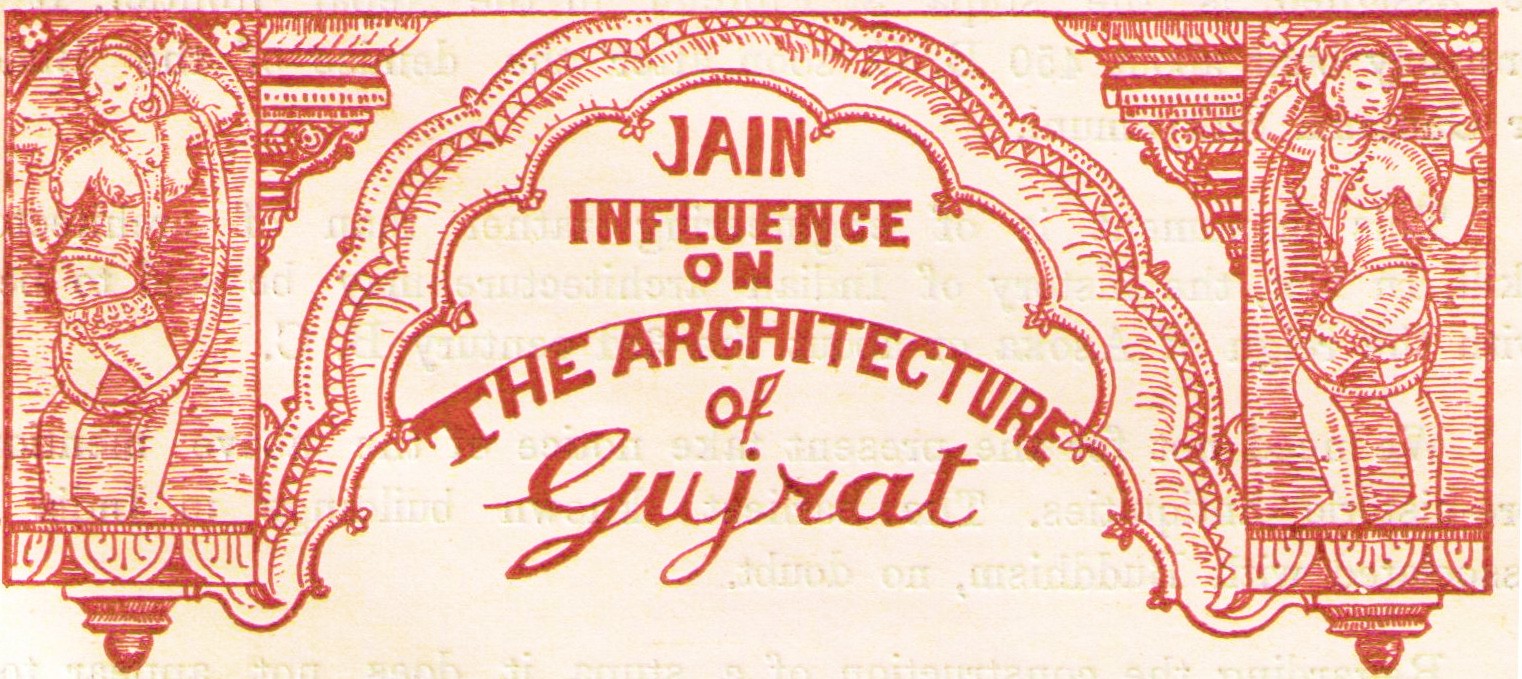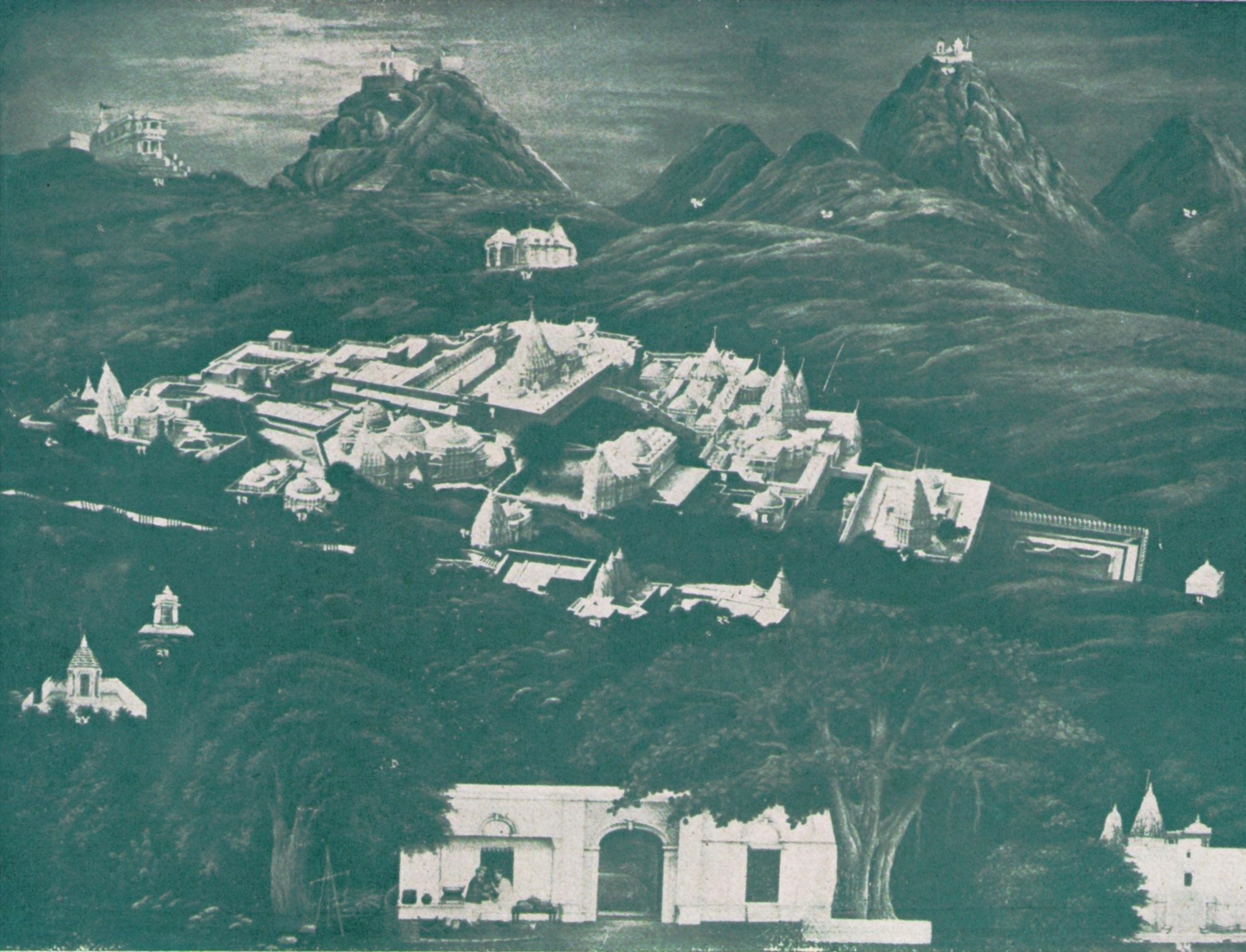
The following article was published in Jainacharya Shri Atmanand Janma Shatabdi Smarak Grantha (Jainacharya Shri Atmanand Centenary Commemoration Volume), edited by Mohanlal Dalichand Desai, Bombay 1936, pp. 63-66.
Jain Influence on the Architecture of Gujarat
India does not possess very ancient structures. Excavations at Mohenjo-daro in Sind and Harappa in the Punjab have revealed remains of several cities super-imposed on one another which flourished some 6000 years ago. These are remnants of large and populous cities having well-built houses, temples and public buildings of brick-masonry. They are the indications of a highly developed civilization which India possessed during those days. Whether this civilization was indigenous or foreign in origin has not yet been decided. So we may leave it out for the present as this note is not meant for discussing it. We might start float the period when we can stand on a firm ground, I mean, the Maurya period or rather the reign of Asoka the great, the architectural remains of whose glorious rule are still to be found in India. These are mostly in stone and in bricks. The earlier ones which served as models perhaps were in wood and must have perished apparently because of the nature of the material.
There are reasons to believe that the ornamented buildings of ancient India were mainly constructed of timber. Foundations and substructures were of bricks but the superstructure was in wood as we now see in Burma.
The earliest buildings in India to which an approximate date can be assigned is the stupa at Piprchu in the Nepal frontier. It was probably built about 450 B. C. soon after the demise of the Buddha or Gautama Sakyamuni.
This monument is of engineering rather than of architectural skill. In fact, the history of Indian architecture may be said to begin with the reign of Asoka or about the 3rd century B.C.
We need not for the present take notice of the above mentioned pre-historic antiquities. The earliest known buildings in India are associated with Buddhism, no doubt.

Fig. 1: A miniature Jain Temple in metal (15th century)
Regarding the construction of a stupa it does not appear to be quite safe to assert that it was originally only Buddhist. Very old remains of stupas and their representations have been unearthed from the Kankali tila, Muttra, which are decidedly Jaina in origin. They could not have come all of a sudden. All the old religions of India, Brahmanism, Jainism and Buddhism must have drawn on a common storehouse of symbolic and conventional devices. The Jains did erect the stupas surrounded by stone-railings enshrining the corporal remains of their saints in them as did the Buddhists in very early days as is evidenced by the remains found from Muttra. Naturally each religion would try to compete with the other in every good feature. But I am not concerned with the very early days of the history of archi¬tecture in India.
We are now concerned with Gujarat. Here very many important-monuments are decidedly Jaina or constructed by Jain Sects or millionaires. The world-famous Dilwada temples which cost crores rupees were built by the Jains undoubtedly. The sraddha of the Jains for their shrines and Pratimas is well known. The Jains were much more given to temple-building than the Hindus. They attach special merit to the construction of a sanctuary and to the dedications of images of Jinas or Tirthankaras. As they were great temple-builders in Western India or Gujarat, they had in their possession the old works on civil and religious architecture such as the Prasad mandana, Rajavallabha, which they have preserved in their temple libraries. The modern salats owe their knowledge to these treatises. Some Jaina teachers are known to have taught them. Gujarat is the only tract in Western India where the architecture of the past is still a living art. Some of the Jaina Yatis give instructions in these archi¬tectural treatises but as they are not themselves the builders, the rules given in their treatises remain understood in theory but not in practice. On the other hand, the stone-masons or salats are ignorant of Sanskrit and therefore, unable to comprehend the texts. Moreover, there is no patronage either by the state or by private individuals. No buildings are constructed which are of the old style. The result is that the old style has become debased and compares unfavourably with the purer style of earlier and better days. Notwithstanding all this, the tradition is preserved and if rich persons come forward to construct buildings, at least temples, in a pure old style, the art will revive. Chiefs are above religion and नराणं च नराधिपः. But millionaires can do a lot in this respect as was done by the well-known builders of the Abu temple, who are said to have spent more than 120000000 (twelve crores of rupees) on constructing this wonderful monument of Jaina patronage of art. These are two temples built wholly of white marble. They are unsurpassed models of the wonderful style of Jaina or one can say Hindu style of mediaeval architecture. The earlier of these is dedicated to Adinatha and was built by Vimalashah in 1031 (AC.). The later was constructed by Tejahpala two centuries after i.e. 1230 (A.C.).

Fig. 2: श्री गीरनारजि तीर्थ [Shri Girnarji Tirtha]
Countless images owe their consecration to Jaina liberality. Thousands of temples were built by the Jainas, Digambaras as well as Svetambaras. Innumerable paintings and illustrated manuscripts on paper and palm leaves were written by the Jainas, Jaina monks and Jaina nuns. The gigantic image of Sravanabelgola is one of the artistic specimens of Jaina sculpture. The Dilwada temples are most artistic specimens of Jaina temples. These are considered to among the wonders of the world.
The great muni to whose memory this volume is dedicated did enormous work in this connection. Many buildings were constructed in Gujarat under his own influence and several under that of his noble disciples. All this is a proof positive of the Jaina influence on the present day architecture of Gujarat. In the olden days Jaina Kings like Kumarapala caused several structures to be made in Gujarat. Some of them are still standing at Girnar, Idar, Taranga hill, Palitana and other places, though the over-enthusiasts are spoiling them by whitewashing and other silly ways of repairing them. He was a zealous Jaina and did considerable good work in getting noble structures built. But it is remarkable that ministers of most of the Kings of Gujarat from Vanaraja downwards were Jainas. Vastupala and Tejahpala were the ministers and multimillionaires Jaina Grihasthas who will carry the palm for their munificence in building wondrous structures. The wonder is that they got constructed not only the Jaina sanctuaries but Hindu temples and mosques even. What more proof is needed of Jaina patronage of architecture in Gujarat.
I reproduce here a photograph of a late mediaeval (15th century) miniature Jaina temple in metal called Chaturmukha in the inscription cut in its pitha, to give an idea of the temple architecture of Gujarat of the period. This miniature I got for study from muni Punyavijayaji, the learned great grand disciple of the illustrious great Acharya to whose Sacred memory पुण्यस्मृति this volume is inscribed.
In view of all what is stated above it can well be asserted that architecture in Gujarat owes a great debt to Jainas and to great Acharya like Shri Muni Vijayanandasuri Maharaj. Such teachers of humanity are always welcome.
 Dr. Hirananda Sastri
Dr. Hirananda Sastri